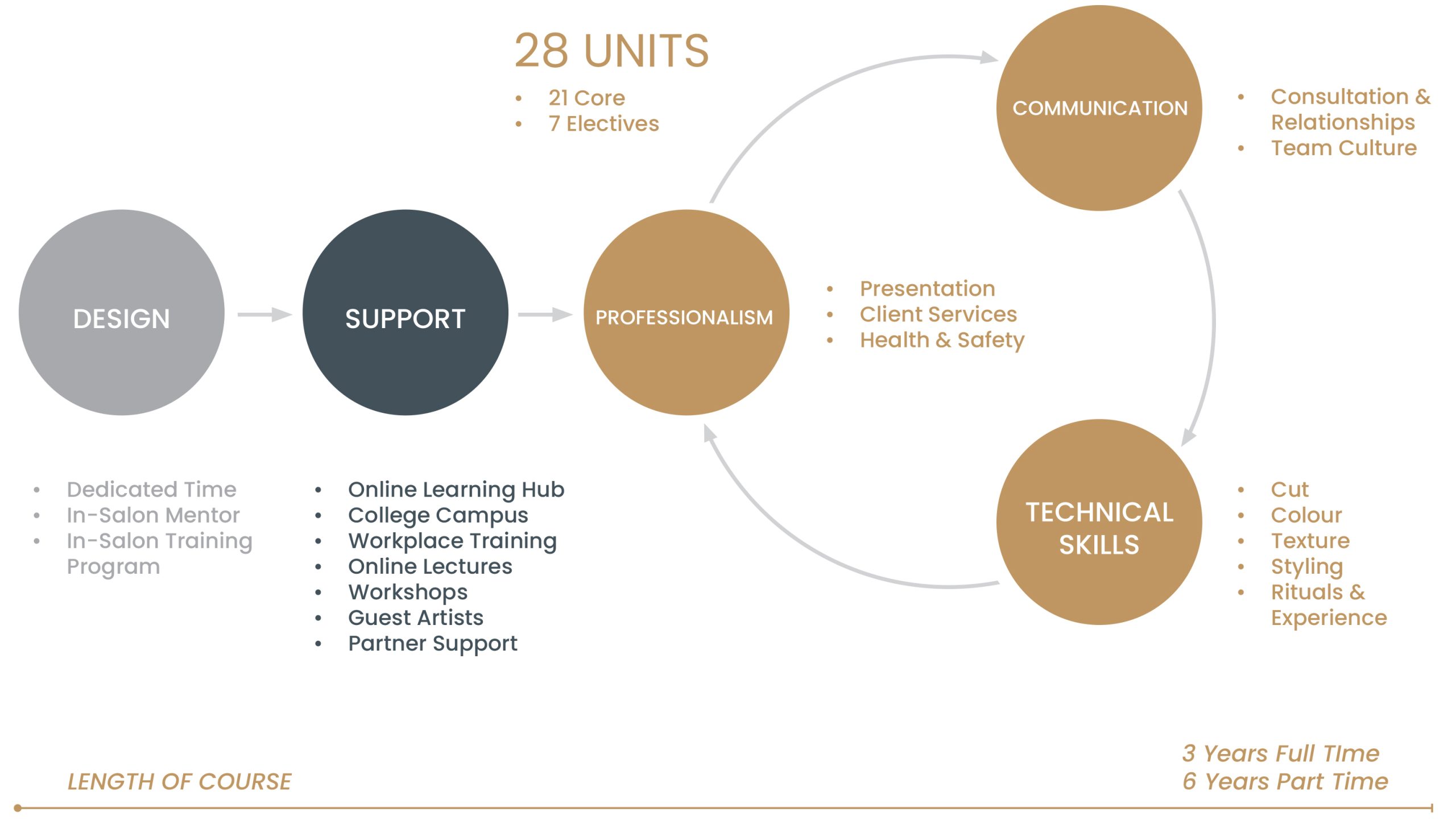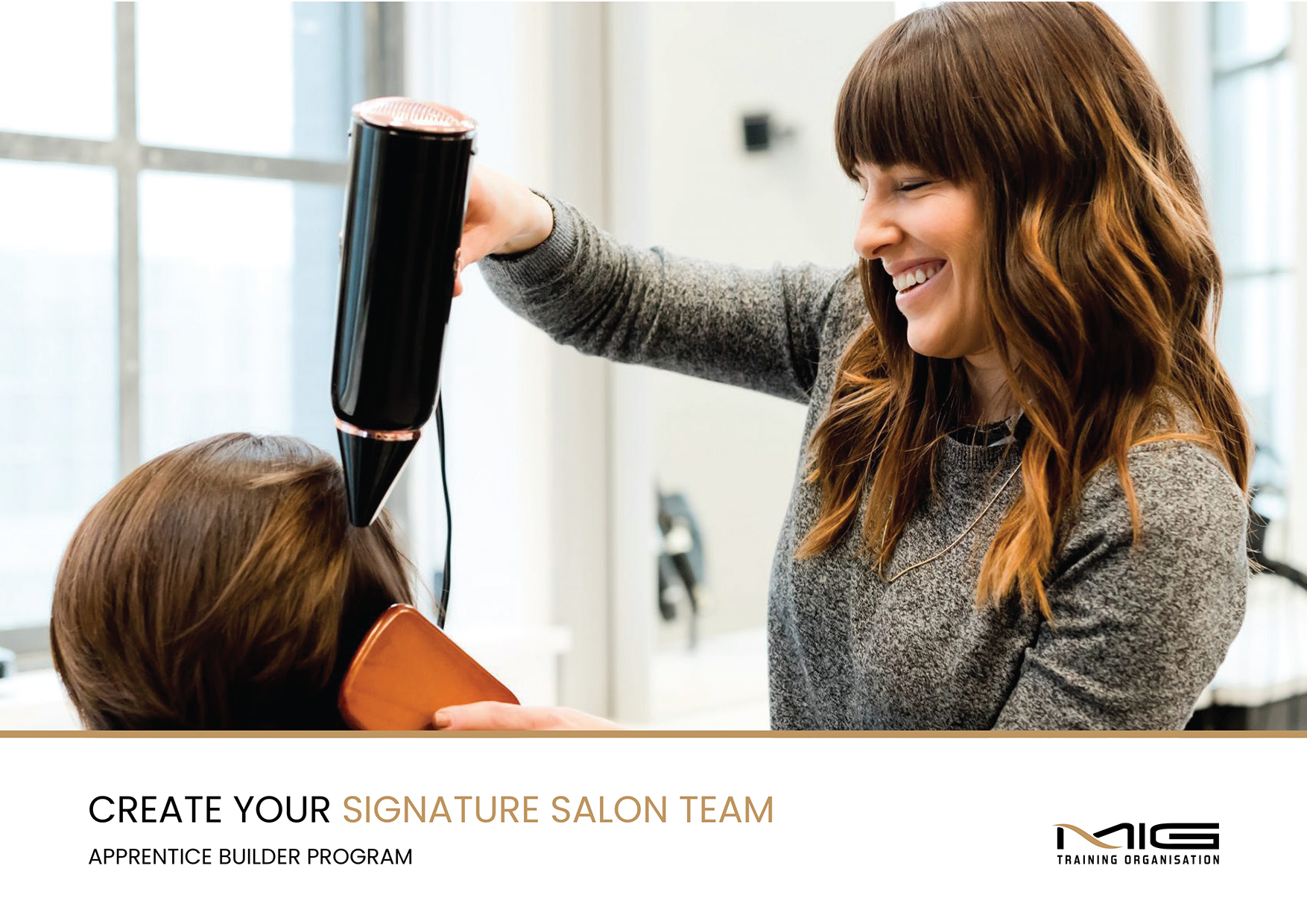MIG has been supporting hairdressing and barber apprentices for more than 30 years
APPRENTICE BUILDER
WE KNOW SALON OWNERSHIP CAN BE OVERWHELMING
Let’s be honest, salon ownership and management can involve working tirelessly for little reward and ever increasing worry, with the daily grind of:
• Finding quality Hairdressers and Barbers
Finding quality people is impossible, getting them to stay is even harder and has a significant impact on your business.
• A dysfunctional team
Managing and motivating hairdressers to build a quality high functioning team.
• Clients only wanting you and no one can do what you do
Are you juggling all the balls at once? Working in and managing your salon while managing staff, finances, marketing and operations can be difficult and all consuming. For this reason, MIG Training has developed the 4-Step Signature Salon Method.
APPRENTICE BUILDER PROGRAM OVERVIEW

MIG SIGNATURE SALON METHOD
MIG has developed the Signature Salon Method to mentor hairdressers and barbers through a four step process to grow and accelerate their salon’s potential and profitability…and retain your health and sanity too!
To combat the pain of working tirelessly for little or no reward, the industries leading salons and barbershops build their Signature Salon Team.
Building a Signature Salon Team is achieved by following our 4 step best practice method.
By focussing on these 5 steps, MIG Training can help you create a highly valued, respected and profitable salon team that represents all of your dreams and aspirations, without the stress.
1. DESIGN
Implementing efficient systems to create the space to build the team.
- • Customised Training Plans
- • Train the trainer
- • Salon Supervisor Coaching and Mentoring
2. SUPPORT
Creating a support network for an easier and more enjoyable experience.
- • Online Learning
- • Workshops
- • Guest Artists
3. PROFEESSIONALISM
Setting and living the standards that matter to attract quality team members.
- • Individual Identity
- • Standards
- • Networks and Industry
4. TECHNICAL SKILLS
Team knowledge and skills that are on point.
- • Cut
- • Colour
- • Texture
- • Styling
- • Rituals & Experience
5. COMMUNICATION
A clear identity, a sharing of ideas and a cohesive team.
- • Consultation and Relationships
- • Community and Partnerships
- • Team Culture
By focussing on these 5 steps, MIG Training can help you create a highly valued, respected and profitable salon team that represents all of your dreams and aspirations, without the stress.
TRY OUR ULTIMATE APPRENTICE BUILDER CHECKLIST – ITS FREE!
Have you got what it takes to develop incredible apprentices?
Our Checklist has been designed to show salons their blind spots and provide instant, actionable steps on how you can improve your business.
- It takes just 2 minutes
- It’s completely free
- Receive customised results instantly
FAQs
I have decided to put on an apprentice. How do I go about it?
Check out this blog and video for a step by step guide https://www.migtraining.com.au/understanding-the-apprenticeship-system/
A good first step is talk to an Australian Apprenticeship Support Network provider (AASN). In summary, to find and contact an AASN based in Qld go to: https://www.australianapprenticeships.gov.au/search-aasn
What happens once you choose MIG?
Within a couple of days of us receiving the Apprentice Notification, yourself and your apprentice will receive a welcome email from MIG. In this email there will be instructions about our online program, Canvas. Your apprentice will also receive an email invitation to create a Canvas account and then complete the enrolment form and Literacy and Numeracy tests. A specialist trainer is then assigned to your apprentice. This trainer will make contact with your apprentice to organise their first induction visit.
Is there a probationary period for apprenticeships?
Each apprenticeship has a probationary period which provides an opportunity for you and your apprentice to work together to assess work ethic, reliability and potential to succeed in the apprenticeship.
What is competency-based training?
Hairdressing and Barbering apprenticeships are competency-based, meaning an apprentice can complete their apprenticeship once they have achieved all units of competency in their training plan and can demonstrate competence in the theory and practical components of each unit.
How quickly can my apprentice complete their apprenticeship?
There are 3 parties to a completion – the apprentice, the employer and the Registered Training Organisation (RTO). Once your apprentice has completed all units of competency in their training plan and can demonstrate competence in the workplace to industry standards, then the formal completion process can be undertaken.
What does flexible delivery meaning?
Formal training and assessment can take many forms. From college-based attendance to MIG visiting in the workplace and anything in between. At MIG we can tailor the training to suit your salon or barbershop. In partnership with the employer MIG develops a training plan that incorporates practical hands-on delivery, mentor support and an online learning and assessment hub.
Do we have to send apprentices to college at all?
A delivery and assessment plan based on what is ideal for the apprentice and the salon or barbershop is put in place at the outset. If resources, structured in salon and formal training is in place then college attendance is not required.
Are we able to choose how and what the apprentice works through?
A training plan is put in place at the outset. Whilst there are core units that must be completed, the elective units can be chosen to reflect the salon or barbershop’s clients and environment. Additionally, the order in which the units are undertaken is for the most part up for grabs and can reflect the priorities for the salon/barbershop.
What counts as formal training?
This article and video link below provide a good summary of what constitutes training. Namely:
- Face to face at college or in the workplace
- Meetings, virtual or otherwise
- Working with the salon supervisor
- Practice
- Observation
- Theory
How much time do we have to allocate to formal training?
The employer obligation for training is to provide the appropriate amount of training negotiated as part of the training plan. This will ensure the apprentice can achieve competency in each of the units from the qualification. There are a number of ways this can be achieved including college attendance and supervised in-salon training.
What level of supervision does an apprentice need?
When you take on an apprentice you are required to have a qualified person to supervise that is employed in the same salon or barbershop and has similar working hours. A copy of the supervisors qualification will be required to be provided to the training organisation. This QLD business video provides a good summary.
How does MIG Training support in-salon training?
At MIG we provide:
- learning resources for the whole salon /barbershop.
- In-salon training plan templates.
- Train the trainer support and education for the salon supervision.
- A dedicated MIG Mentor to support the in- salon training program.
How are the assessments completed?
MIG use a whizzbang online learning and assessment platform called Canvas. Assessment for each unit of competency is broken into a knowledge quiz, a series of practical tasks, and a supervisor’s competency declaration report. The practical tasks can be completed by MIG Educator observation or video upload.
Do I have to pay my apprentice to attend college?
Off the job training including attending college is a normal paid work day. This may not apply to school-based apprentices and trainees. You may need to check the relevant award or contact Fair Work for confirmation.
When does my apprentice progress to the next wage level?
For enquiries about wages, entitlements and wage progression, phone Fair Work Ombudsman on 13 13 94 for help in determining the correct industrial instrument and entitlements.
Prepare for the phone call by checking what information you may need during the call.
My apprentice or trainee is falling behind in their training. What should I do?
Managing progression is a critical part of the partnership between MIG, the employer and apprentice. MIG will regularly discuss progression. It is important to note that if your apprentice or trainee is falling behind, there is an obligation for the employer and/or training organisation to notify your Australian Apprenticeship Support Network provider (AASN) or the QLD Department of Employment Small Business and Training to discuss options.
Business is slow and I can't provide the range of work required for my apprentice or trainee. What are my options?
If you are temporarily unable to provide the range of work required to train your apprentice, due to a lack of work, business being slow, or other factors, there are options available for your apprentice to continue their apprenticeship. Business Queensland has some great resources: Resolving issues with my apprentice or trainee.
What is involved in moving apprentices to MIG?


